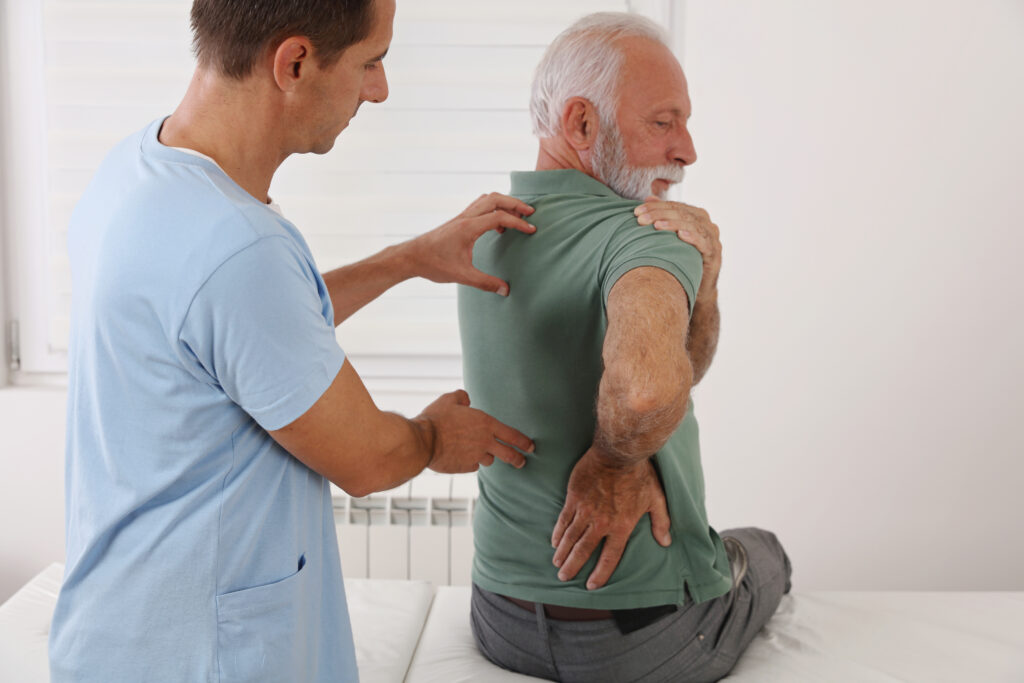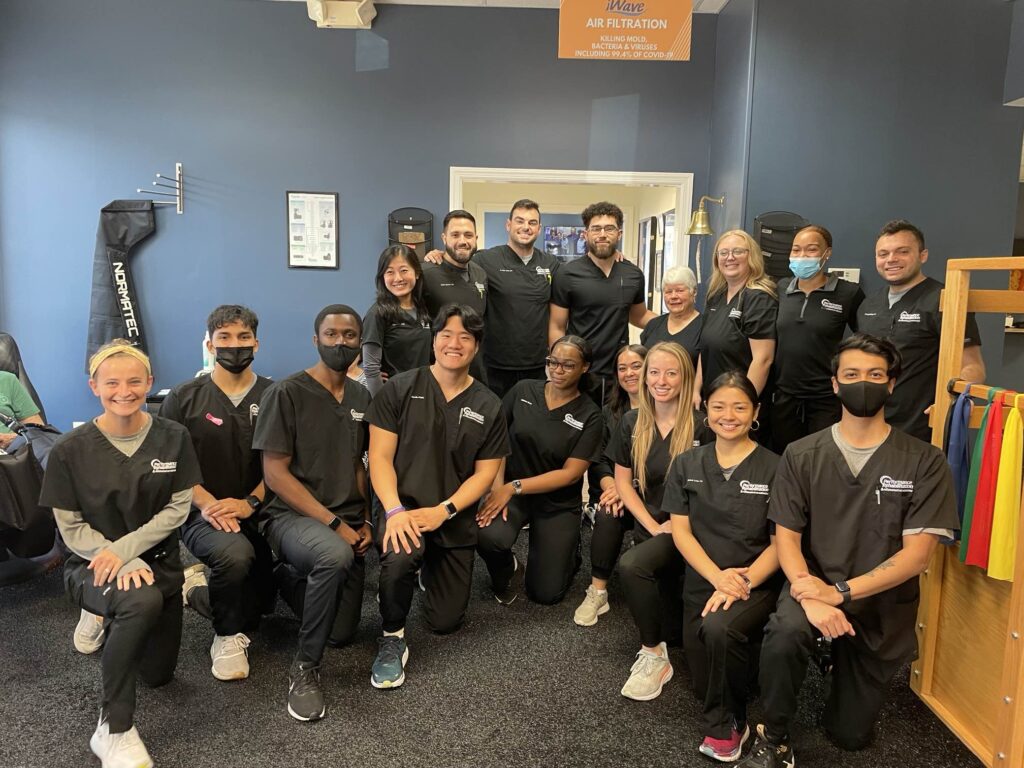Facing Spinal Stenosis With A Team-Based Approach
Spinal Stenosis Specialists in Somerset County, New Jersey
Table of Contents
Spinal stenosis is a condition where the spaces within your spine narrow, which can put pressure on the nerves that travel through the spine. Spinal stenosis is common in the lower back and neck. Osteoarthritis often causes wear-and-tear in the spine. In severe cases of spinal stenosis, doctors may recommend surgery to create additional space for the nerves or spine. However, many people with spinal stenosis can manage their symptoms with non-surgical treatments.
What is Spinal Stenosis?
Spinal stenosis involves the narrowing of the spinal canal, which can compress the spinal cord and nerve roots. This compression can lead to symptoms such as pain, numbness, muscle weakness, and impaired bladder or bowel control.
Causes and Risk Factors for Spinal Stenosis
– Age-related wear and tear
– Herniated disks
– Thickened ligaments
– Spinal injuries
– Tumors
– Certain bone diseases
Non-Surgical Relief for Spinal Stenosis
– Physical therapists can teach you exercises to strengthen your back, improve balance, and increase flexibility.
– Aerobic exercises, such as walking, can improve endurance and help maintain a healthy weight.
2. Medications
– Over-the-counter pain relievers like ibuprofen or naproxen can help ease pain and inflammation.
– In some cases, your doctor might prescribe antidepressants or anti-seizure drugs to relieve pain stemming from nerve damage.
– Corticosteroid injections can reduce inflammation and relieve pain temporarily. However, these injections are typically limited to a few per year due to potential side effects.
4. Lifestyle Modifications
– Maintain a healthy weight to reduce stress on your spine.
– Avoid activities that worsen your symptoms, and take breaks when needed.
– Apply heat or cold to the affected area to ease pain.
– Acupuncture or chiropractic treatment can sometimes provide relief.
– Mind-body therapies like yoga and tai chi can increase flexibility and reduce pain.
– Braces or corsets can provide support and help relieve pain.
– Using walking aids like canes or walkers can help in maintaining balance and stability.
When to Consider Surgery for Spinal Stenosis
If non-surgical treatments aren’t effective in relieving your symptoms, or if you’re experiencing severe pain or disability, surgery might be an option. Surgery aims to relieve pressure on your spinal cord or nerves. This is done by removing bone or tissue or by making the spinal canal bigger. It’s important to discuss the potential risks and benefits of surgery with your doctor.
Doctors use the MILD procedure as an advanced outpatient treatment for lumbar spinal stenosis. The MILD procedure for lumbar spinal stenosis is different from other surgeries. It doesn’t need a big cut, stitches, anesthesia, or an implant. It also does not require the use of steroids or opioids.
The MILD procedure is done with a small incision and special tools to remove bone and ligament causing spinal canal narrowing. This helps with lumbar spinal stenosis and reduces pressure on the spinal cord and nerves, relieving pain and improving mobility.
Why A Team-Based Approach Matters?
A team-based approach in treating spinal stenosis involves multidisciplinary collaboration among various healthcare professionals, each contributing their expertise to create a comprehensive and personalized treatment plan. At Performance, this means you will receive the highest level of care with a large team of providers supporting you. This approach is highly beneficial in managing complex conditions like spinal stenosis, where symptoms and treatment responses can vary greatly among individuals. Here’s how a team-based approach can be particularly effective:
1. Comprehensive Assessment
– Specialists Involved: Orthopedic surgeons, neurosurgeons, pain management specialists, physical therapists, occupational therapists, acupuncturists, and physiatrists.
– Benefits: Provides a thorough evaluation from multiple perspectives, ensuring all aspects of the condition, including underlying causes and contributing factors, are considered.
2. Personalized Treatment Plans
– Collaboration: The team at Performance collaboratively develops a treatment plan tailored to the patient’s specific symptoms, overall health, lifestyle, and treatment goals.
– Flexibility: The plan can be adjusted as needed based on the patient’s response to treatment.
3. Multifaceted Treatment Options
– Diverse Expertise: Each specialist contributes different treatment modalities such as medication management, physical therapy, surgical options, and pain management techniques.
– Comprehensive Care: This ensures that all potential treatment avenues are explored and the patient receives well-rounded care, before jumping to surgery.
4. Coordinated Care
– Communication: Regular team meetings and communication channels ensure that all team members are informed about the patient’s progress and treatment adjustments.
– Efficiency: This coordination can lead to more efficient care, reducing the need for repeated tests and appointments with different specialists.
5. Emphasis on Rehabilitation and Recovery
– Physical Therapists and Occupational Therapists: They play a crucial role in the patient’s rehabilitation, focusing on exercises and activities that improve strength, flexibility, and function.
– Long-term Management: Rehabilitation professionals can also provide education on managing symptoms and preventing future complications.
6. Regular Follow-Ups and Monitoring
– Proactive Management: The team approach facilitates regular monitoring of the patient’s condition and quick response to any changes in symptoms.
– Long-term Care: It helps in managing spinal stenosis as a chronic condition, with adjustments in treatment as needed over time.
The team-based approach to treating spinal stenosis is advantageous because it brings together diverse expertise and perspectives, leading to a more holistic understanding and treatment of the condition. It emphasizes personalized care, efficient coordination, and addresses both the physical and psychological aspects of spinal stenosis, aiming for the best possible outcomes in symptom management and quality of life.
Living with spinal stenosis can be challenging, but there are many ways to manage your symptoms and maintain an active life. It’s important to work closely with your healthcare provider to develop a treatment plan that’s right for you. Regular exercise, maintaining a healthy weight, and following your treatment plan can help manage the symptoms of spinal stenosis effectively.
Each person’s situation is different, so it’s important to talk to healthcare professionals for personalized advice and treatment choices. Click to request a consultation today, or give us a call at 908-754-1960.



